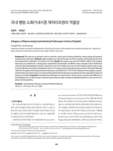

-
서지정보
· 발행기관 : 한국기초간호학회
· 수록지 정보 : Journal of Korean Biological Nursing Science / 18권 / 4호 / 288 ~ 295페이지
· 저자명 : 김영옥, 정재심
초록
Background: This study was conducted in order to survey the current state of cleaning, disinfection, rinsing, drying, and storage of gastrointestinal endoscopes. Methods: Eighty hospitals were selected through convenient sampling. Self-reported questionnaire was distributed from September 14 to October 10 in 2015. Results: The response rate was 67.5% (54/80). In 88.9% of the hospitals, reprocessing was performed in a cleaning space separated from the laboratory and 88.9% used an enzymatic cleaner. Disinfectants used were ortho-phthalaldehyde in 63.0%, and paracetic acid in 33.3%. Eighty seven percent of the hospitals used test strips in order to test the effective concentration of disinfectant and in 61.1%, drying was done through passing air and over 70% alcohol. Microbial culture for the quality control of gastrointestinal endoscopes was performed in 77.8%. In the comparison of the adequacy of gastrointestinal endoscope reprocessing, it was observed that gastrointestinal endoscopes were reprocessed more adequately in larger and tertiary care hospitals. Conclusion: Gastrointestinal endoscopes were reprocessed in similar manners, but there were differences in the detailed process. It is still necessary to segment reprocessing into stages, to prepare standardized guidelines, and to monitor compliance with the guidelines.영어초록
Background: This study was conducted in order to survey the current state of cleaning, disinfection, rinsing, drying, and storage of gastrointestinal endoscopes. Methods: Eighty hospitals were selected through convenient sampling. Self-reported questionnaire was distributed from September 14 to October 10 in 2015. Results: The response rate was 67.5% (54/80). In 88.9% of the hospitals, reprocessing was performed in a cleaning space separated from the laboratory and 88.9% used an enzymatic cleaner. Disinfectants used were ortho-phthalaldehyde in 63.0%, and paracetic acid in 33.3%. Eighty seven percent of the hospitals used test strips in order to test the effective concentration of disinfectant and in 61.1%, drying was done through passing air and over 70% alcohol. Microbial culture for the quality control of gastrointestinal endoscopes was performed in 77.8%. In the comparison of the adequacy of gastrointestinal endoscope reprocessing, it was observed that gastrointestinal endoscopes were reprocessed more adequately in larger and tertiary care hospitals. Conclusion: Gastrointestinal endoscopes were reprocessed in similar manners, but there were differences in the detailed process. It is still necessary to segment reprocessing into stages, to prepare standardized guidelines, and to monitor compliance with the guidelines.참고자료
· 없음태그
-
자주묻는질문의 답변을 확인해 주세요

꼭 알아주세요
-
자료의 정보 및 내용의 진실성에 대하여 해피캠퍼스는 보증하지 않으며, 해당 정보 및 게시물 저작권과 기타 법적 책임은 자료 등록자에게 있습니다.
자료 및 게시물 내용의 불법적 이용, 무단 전재∙배포는 금지되어 있습니다.
저작권침해, 명예훼손 등 분쟁 요소 발견 시 고객센터의 저작권침해 신고센터를 이용해 주시기 바랍니다. -
해피캠퍼스는 구매자와 판매자 모두가 만족하는 서비스가 되도록 노력하고 있으며, 아래의 4가지 자료환불 조건을 꼭 확인해주시기 바랍니다.
파일오류 중복자료 저작권 없음 설명과 실제 내용 불일치 파일의 다운로드가 제대로 되지 않거나 파일형식에 맞는 프로그램으로 정상 작동하지 않는 경우 다른 자료와 70% 이상 내용이 일치하는 경우 (중복임을 확인할 수 있는 근거 필요함) 인터넷의 다른 사이트, 연구기관, 학교, 서적 등의 자료를 도용한 경우 자료의 설명과 실제 자료의 내용이 일치하지 않는 경우
찾으시던 자료가 아닌가요?
지금 보는 자료와 연관되어 있어요!
문서 초안을 생성해주는 EasyAI




